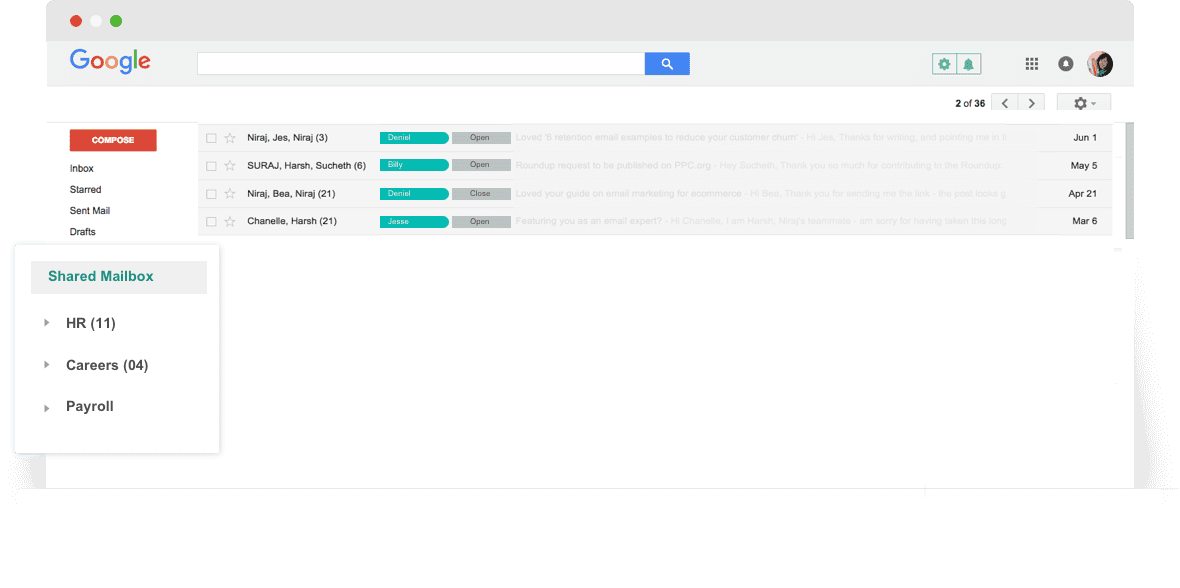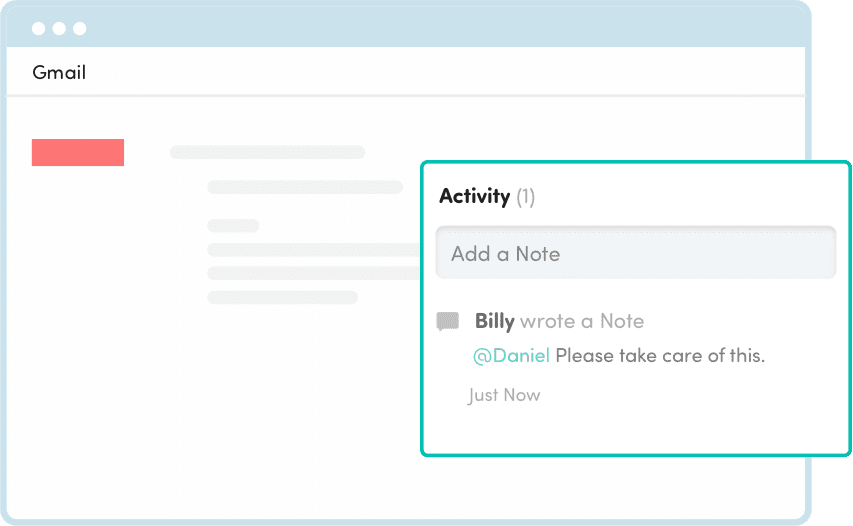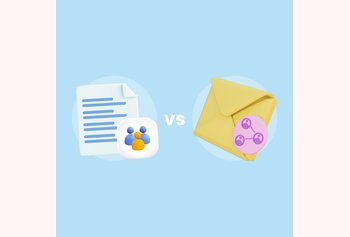
Table of contents
Hiver transforms Gmail into your team's collaborative workspace

How to Make Email Collaboration Work for Teams

Table of contents
Back in 1971, the very first, rudimentary form of email was invented by Ray Tomlinson.
Fast forward to 2022, nearly five decades later, even with the proliferation of social media and other messaging apps in our lives, email is still as popular as ever with over 4 billion active users.
Apart from being used in personal communications, email, as we know, is an integral communication tool in today’s business culture. In fact, email collaboration plays a crucial role in enabling teams such as support and sales to collectively handle their day-to-day tasks with ease and efficiency.
For the uninitiated, email collaboration is a system where several members of a team work from a single inbox. For instance, members of your customer support team can log into a group inbox (say [email protected]) to work together to handle support emails that come in on a daily basis. This allows team members to share their workload and respond to incoming queries faster.
Sounds pretty straightforward. Until you discover a fundamental flaw.
You see, email was designed for one-to-one communication and that’s where it excels.
And the truth is, when email becomes a standalone platform for collaboration, it ends up leaving teams frustrated.
Let’s find out why.
Table of Contents
- Where does Email fail?
- Why managing Team Emails isn’t for the faint-hearted
- The simplest way to manage team emails
- Next steps
- Looking to try out Hiver?
Where does Email fail?
Let’s go through a few scenarios where teams would normally use email for collaboration.
- While working on a project: Team members use email to share project-related information internally and also to stay in constant touch with the client about the status of the project. Email is still a widespread communication channel during team projects even in the age of project management tools.
- Communications between departments: For instance, when the sales team wants their bills reimbursed, they’d get in touch with the finance department by mailing a group ID such as finance@.
- Handling customer queries and other external requests: Every company today has a group inbox like support@ or info@ to manage external queries. Such group inboxes usually have multiple team members logging in and working together, to process emails coming in on a daily basis.
As you can see, especially from the 2nd and 3rd scenario, a group inbox – either internal or external – involves a lot of collaborative effort, as teams would want to view and delegate emails, and also keep track of who is working on what email.
That being said, doing this isn’t as straightforward as it seems.
Imagine a customer wanting to reach out to your company regarding a query or issue. They’d most probably send a message to one of your generic email addresses like info@, support@ or help@.
Now, we all have been in this situation, haven’t we? Where we keep emailing companies, waiting forever for a response.
It’s not that brands don’t want to get back to you on time. They simply don’t have the means to keep track of all these emails. And that’s because there are quite a few pitfalls to using email collaboration for teams.
Why managing Team Emails isn’t for the faint-hearted
If your teams use Gmail for work, there are a couple of ways to go about managing team email collaboration.
One common approach is to create one single Gmail account to process team emails in inboxes like info@ or support@. Then share the credentials with everyone in your team and have all of them log into the same Gmail account.
This method of managing team emails, however, has several blatant drawbacks.
- Chances of getting blocked: Multiple people accessing a team email from the same account alerts Google – they constantly track IP addresses. And there’s a high chance the account gets blocked permanently.
- Lots of back and forth: Since team members have to log into a separate inbox to access team emails, they’ll have to keep switching between this inbox and their personal account.
- Lack of ownership: If an email has just arrived in a shared inbox, there’s no way for anyone in your team to know who needs to take it up.
- Minimal clarity: Gmail doesn’t have the functionality to inform teams who is working on which email. Without this piece of information, you start missing out on emails as there’s absolutely no clarity across the team.
- Dip in productivity: When using Gmail, there’s no single place to look at all the emails assigned to you and what you need to do for the day. Consequently, you end up wasting time just figuring out your tasks.
- More email clutter: The only way to delegate or assign an email to someone is by forwarding that email to them. This means more emails, more inbox clutter.
The second way to go about managing collaborative emails is by using a Google Collaborative Inbox. The advantage here is that teams no longer have to log into the same account for managing emails. However, the Google Collaborative Inbox has its own issues.
- The UI is tacky: Being a brainchild of Google, you might be led to believe that the Collaborative Inbox is as intuitive as other Google products. But it’s not. The Collaborative Inbox doesn’t look anything like Gmail and comes with a very mediocre and sloppy interface.
- Takes time to get used to: Your teams need to get up to speed with an alien platform (pretty alien, if you compare with Gmail!). On top of that, they will have to constantly toggle between their personal inbox and the collaborative inbox – emails slipping through the cracks wouldn’t be a rare sight.
- Replication of work:When your team isn’t sure if an email has been acted upon, there’s a high chance that more than one person ends up replying to the same email. Imagine the kind of impression you’d create for a customer or prospect.
- Again, more emails:Just like Gmail, the Collaborative Inbox doesn’t offer an easy way for team members to communicate within the team – you’ll have to send more emails to get inputs, take help, or discuss work.
So, how do you efficiently manage the everyday barrage of team emails?
Hit a Google search on using ‘Email for team collaboration’ and you’ll find 9 out of 10 articles advising you to stop using Email altogether. Given the drawbacks of collaborating over team emails, it might definitely sound like a plausible option.
But, getting rid of Email only makes you less approachable to customers and prospects. Also, without Email, you’d have to get everyone in your team up to speed with an entirely new email collaboration tool. This is not only time-consuming but also comes with its own costs.
The simplest way to manage team emails
What if you could manage team emails right from your Gmail inbox, without breaking a sweat? What if you are able to keep track of what everyone is doing in your team, enable smooth internal discussions, and ultimately build accountability?
This is where Hiver comes into the picture. Hiver is an easy-to-use customer support solution that enables businesses to manage team emails directly from Gmail.
Do everything from Gmail
The biggest advantage of using Hiver is that your teams no longer have to switch between multiple tabs for managing team emails. Be it one-on-one communications or emails coming to a support@ or info@ inbox, your team members can handle everything from their personal Gmail accounts.

Build ownership and accountability within teams
With Hiver, every team email can be given an owner and a status. Meaning, you can keep track of who is doing what. Most importantly, every team member knows exactly what they have to do on a daily basis. So, there’s very little confusion within teams and consequently, everyone becomes a lot more efficient.
Manage discussions around emails with ease
Hiver’s Shared Drafts allows your team members to collaboratively draft emails in real-time. This way you can craft perfect emails together but without the endless back and forth and the hassle of multiple replies.
You can invite your team members to edit shared drafts with a single click. And the best part is that you don’t have to rely on any external collaboration tools.
Boost productivity by automating repetitive tasks
Support teams often grapple with repetitive tasks like assigning emails to team members, categorizing emails, and clearing inbox clutter.
With Hiver you can ensure that your agents are not losing out valuable time on redundant, mundane tasks. Hiver’s automations allow agents to auto assign emails based on predefined conditions. You can also use email Tags to automatically categorize incoming emails based on certain criteria, saving you time and effort. For instance, all emails coming from [email protected] can be tagged as ‘Priority’. Or emails containing the terms ‘invoice’ or ‘payment’ in the subject line can be tagged as ‘Finance’.
Enable seamless internal communication
When collaborating over email, the only way a team member can communicate with a colleague is by sending another email. This opens up the possibility of internal and external emails getting mixed – that’s never a good thing as one small slip up can result in an internal conversation leaking to a customer or a prospect.
Hiver eliminates the need to send more emails. Team members can talk to each other using quick, contextual notes which are attached alongside the email thread. No more internal forwards or CCs!

Monitor team and individual performances
At the end of the day, great team collaboration should make every team member better at what they do. On that note, Hiver helps you track key metrics to measure individual performances.
Find out how everyone in your team is performing – How quickly are they resolving team emails? How many tasks are they able to complete? Are customers/prospects satisfied after having an interaction with your team members?
Next steps
While email is definitely an integral tool for collaboration, it does need that extra push to make it work better and more efficiently for your teams.
And this is where Hiver comes in. With features like easy email assignment and tracking, contextual notes and automations, it allows your teams to collaborate seamlessly and enables them to stay productive.




































